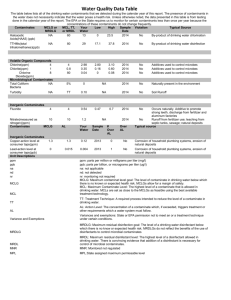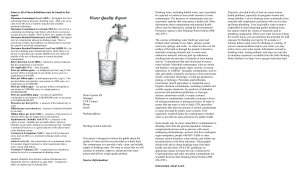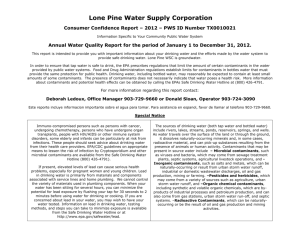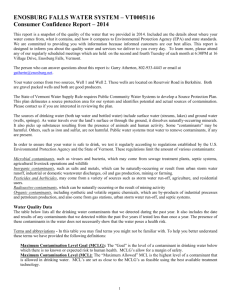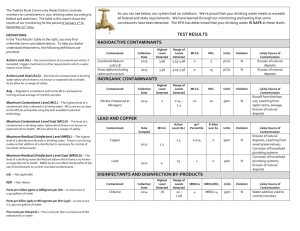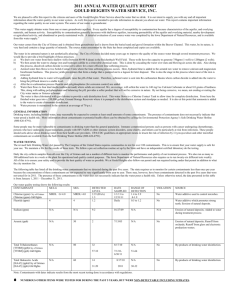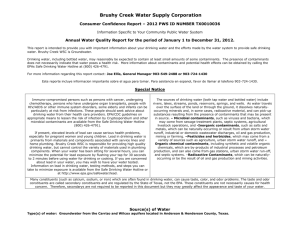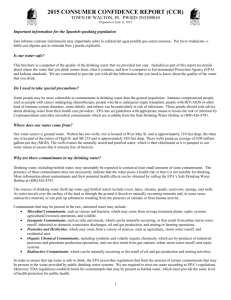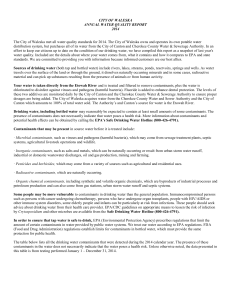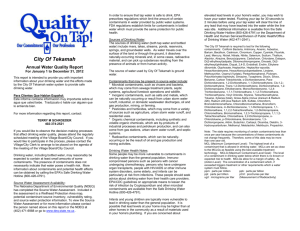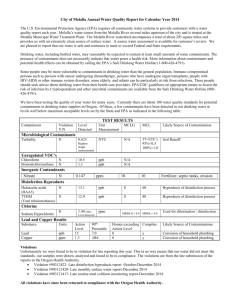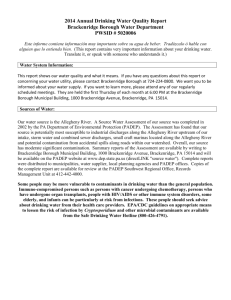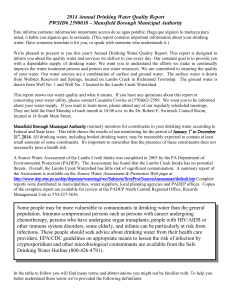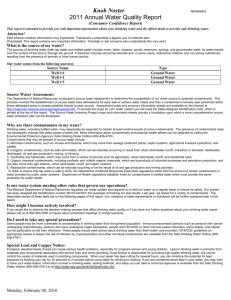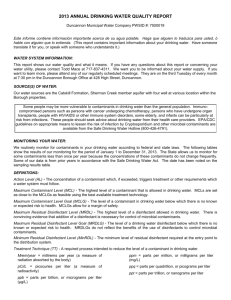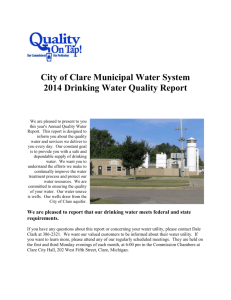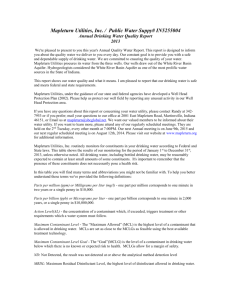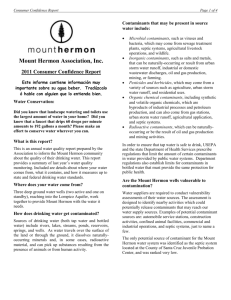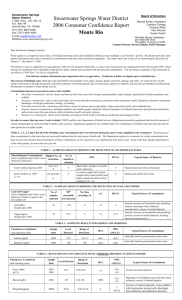FRWA / DEP - Panacea Area Water
advertisement
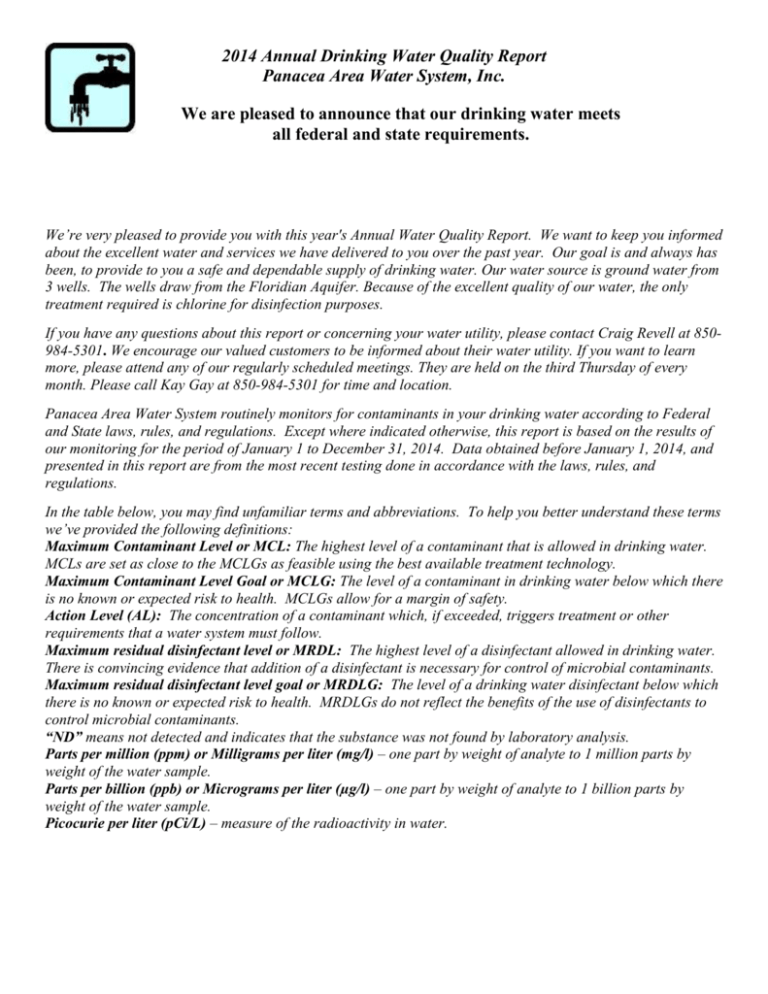
2014 Annual Drinking Water Quality Report Panacea Area Water System, Inc. We are pleased to announce that our drinking water meets all federal and state requirements. We’re very pleased to provide you with this year's Annual Water Quality Report. We want to keep you informed about the excellent water and services we have delivered to you over the past year. Our goal is and always has been, to provide to you a safe and dependable supply of drinking water. Our water source is ground water from 3 wells. The wells draw from the Floridian Aquifer. Because of the excellent quality of our water, the only treatment required is chlorine for disinfection purposes. If you have any questions about this report or concerning your water utility, please contact Craig Revell at 850984-5301. We encourage our valued customers to be informed about their water utility. If you want to learn more, please attend any of our regularly scheduled meetings. They are held on the third Thursday of every month. Please call Kay Gay at 850-984-5301 for time and location. Panacea Area Water System routinely monitors for contaminants in your drinking water according to Federal and State laws, rules, and regulations. Except where indicated otherwise, this report is based on the results of our monitoring for the period of January 1 to December 31, 2014. Data obtained before January 1, 2014, and presented in this report are from the most recent testing done in accordance with the laws, rules, and regulations. In the table below, you may find unfamiliar terms and abbreviations. To help you better understand these terms we’ve provided the following definitions: Maximum Contaminant Level or MCL: The highest level of a contaminant that is allowed in drinking water. MCLs are set as close to the MCLGs as feasible using the best available treatment technology. Maximum Contaminant Level Goal or MCLG: The level of a contaminant in drinking water below which there is no known or expected risk to health. MCLGs allow for a margin of safety. Action Level (AL): The concentration of a contaminant which, if exceeded, triggers treatment or other requirements that a water system must follow. Maximum residual disinfectant level or MRDL: The highest level of a disinfectant allowed in drinking water. There is convincing evidence that addition of a disinfectant is necessary for control of microbial contaminants. Maximum residual disinfectant level goal or MRDLG: The level of a drinking water disinfectant below which there is no known or expected risk to health. MRDLGs do not reflect the benefits of the use of disinfectants to control microbial contaminants. “ND” means not detected and indicates that the substance was not found by laboratory analysis. Parts per million (ppm) or Milligrams per liter (mg/l) – one part by weight of analyte to 1 million parts by weight of the water sample. Parts per billion (ppb) or Micrograms per liter (µg/l) – one part by weight of analyte to 1 billion parts by weight of the water sample. Picocurie per liter (pCi/L) – measure of the radioactivity in water. 2014 CONTAMINANTS TABLE Contaminant and Unit of Measurement Dates of sampling (mo./yr.) MCL Violation Y/N Level Detected Range of Results MCLG MCL Likely Source of Contamination Radioactive Contaminants Alpha emitters (pCi/L) Aug-09 N 2.4 1.7-2.4 0 15 Radium 226 + 228 or combined radium (pCi/L) Aug-09 N 1 0.9-1 0 5 Erosion of natural deposits Erosion of natural deposits Inorganic Contaminants Barium (ppm) Sept-12 N 0.027 0.018-0.027 2 2 Nitrate (as Nitrogen) (ppm) Aug-14 N 0.23 ND-0.23 10 10 Sodium (ppm) Sept-12 N 51 16 -51 N/A 160 Chromium (ppb) Sept-12 N 5.5 2.7-5.5 100 100 Nickel (ppb) Sept-12 N 3.3 2.5-3.3 NA 100 Contaminant and Unit of Measurement Dates of MCL sampling (mo./yr.) Violation Y/N Level Detected Range of Results MCLG or MRDLG Discharge of drilling wastes; discharge from metal refineries; erosion of natural deposits Runoff from fertilizer use; leaching from septic tanks, sewage; erosion of natural deposits Salt water intrusion, leaching from soil Discharge from steel and pulp mills; erosion of natural deposits Pollution from mining and refining operations. Natural occurrence in soil MCL or MRDL Likely Source of Contamination Stage 2 Disinfectant/Disinfection By-Product (D/DBP) Chlorine (ppm)Stage 1 Haloacetic Acids (five) (HAA5) (ppb) TTHM [Total trihalomethanes] (ppb) Contaminant and Unit of Measurement Jan-Dec 14 N 0.69 0.490.93 MRDLG =4 MRDL = 4.0 Water additive used to control microbes July-14 N 5.5 4.5-5.5 NA MCL = 60 By-product of drinking water disinfection July-14 N 30.4 29.930.4 NA MCL = 80 By-product of drinking water disinfection Dates of sampling (mo./yr.) AL Exceeded Y/N 90th Percentile Result No. of sampling sites exceeding the AL MCLG AL (Action Level) Likely Source of Contamination Lead and Copper (Tap Water) Copper (tap water) (ppm) JuneSept 12 N 0.56 0 of 10 1.3 1.3 Lead (tap water) (ppb) JuneSept-12 N 4.9 0 of 10 0 15 Corrosion of household plumbing systems; erosion of natural deposits; leaching from wood preservatives Corrosion of household plumbing systems, erosion of natural deposits Drinking water, including bottled water, may reasonably be expected to contain at least small amounts of some contaminants. The presence of contaminants does not necessarily indicate that the water poses a health risk. More information about contaminants and potential health effects can be obtained by calling the Environmental Protection Agency’s Safe Drinking Water Hotline at 1-800-426-4791. The sources of drinking water (both tap water and bottled water) include rivers, lakes, streams, ponds, reservoirs, springs, and wells. As water travels over the surface of the land or through the ground, it dissolves naturally occurring minerals and, in some cases, radioactive material, and can pick up substances resulting from the presence of animals or from human activity. If present, elevated levels of lead can cause serious health problems, especially for pregnant women and young children. Lead in drinking water is primarily from materials and components associated with service lines and home plumbing. Panacea Area Water System is responsible for providing high quality drinking water, but cannot control the variety of materials used in plumbing components. When your water has been sitting for several hours, you can minimize the potential for lead exposure by flushing your tap for 30 seconds to 2 minutes before using water for drinking or cooking. If you are concerned about lead in your water, you may wish to have your water tested. Information on lead in drinking water, testing methods, and steps you can take to minimize exposure is available from the Safe Drinking Water Hotline or at http://www.epa.gov/safewater/lead. Contaminants that may be present in source water include: (A) Microbial contaminants, such as viruses and bacteria, which may come from sewage treatment plants, septic systems, agricultural livestock operations, and wildlife. (B) Inorganic contaminants, such as salts and metals, which can be naturally-occurring or result from urban stormwater runoff, industrial or domestic wastewater discharges, oil and gas production, mining, or farming. (C) Pesticides and herbicides, which may come from a variety of sources such as agriculture, urban stormwater runoff, and residential uses. (D) Organic chemical contaminants, including synthetic and volatile organic chemicals, which are by-products of industrial processes and petroleum production, and can also come from gas stations, urban stormwater runoff, and septic systems. (E) Radioactive contaminants, which can be naturally occurring or be the result of oil and gas production and mining activities. In order to ensure that tap water is safe to drink, the EPA prescribes regulations, which limit the amount of certain contaminants in water provided by public water systems. The Food and Drug Administration (FDA) regulations establish limits for contaminants in bottled water, which must provide the same protection for public health. In our continuing efforts to maintain a safe and dependable water supply, it may be necessary to make improvements in your water system. The costs of these improvements may be reflected in the rate structure. Rate adjustments may be necessary in order to address these improvements. In 2014 the Department of Environmental Protection performed a Source Water Assessment on our system. The assessment was conducted to provide information about any potential sources of contamination in the vicinity of our wells. There are no potential source of contamination identified for this system. The assessment results are available on the FDEP Source Water Assessment and Protection Program website at www.dep.state.fl.us/swapp or they can be obtained from Panacea Area Water System. Some people may be more vulnerable to contaminants in drinking water than the general population. Immunocompromised persons such as persons with cancer undergoing chemotherapy, persons who have undergone organ transplants, people with HIV/AIDS or other immune system disorders, some elderly, and infants can be particularly at risk from infections. These people should seek advice about drinking water from their health care providers. EPA/CDC guidelines on appropriate means to lessen the risk of infection by Cryptosporidium and other microbiological contaminants are available from the Safe Drinking Water Hotline (800-426-4791). We at Panacea Area Water System work around the clock to provide top quality water to every tap. We ask that all our customers help us protect our water sources, which are the heart of our community, our way of life and our children’s future.



